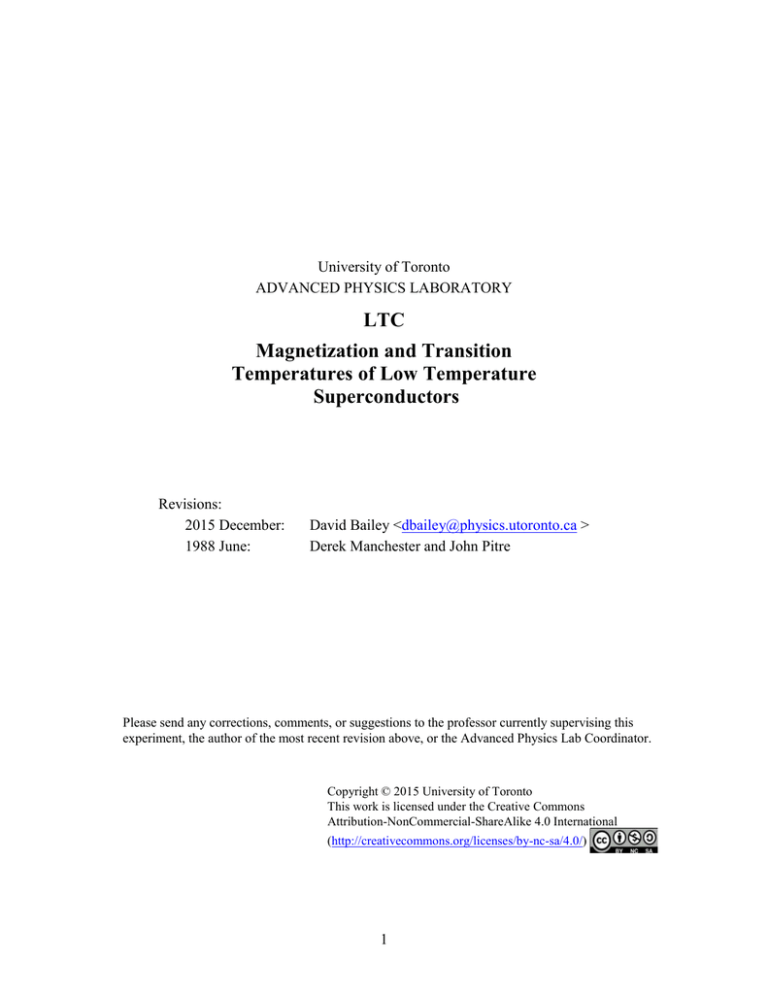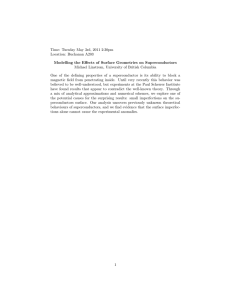LTC Magnetization and Transition Temperatures of Low Temperature Superconductors
advertisement

University of Toronto ADVANCED PHYSICS LABORATORY LTC Magnetization and Transition Temperatures of Low Temperature Superconductors Revisions: 2015 December: 1988 June: David Bailey <dbailey@physics.utoronto.ca > Derek Manchester and John Pitre Please send any corrections, comments, or suggestions to the professor currently supervising this experiment, the author of the most recent revision above, or the Advanced Physics Lab Coordinator. Copyright © 2015 University of Toronto This work is licensed under the Creative Commons Attribution-NonCommercial-ShareAlike 4.0 International (http://creativecommons.org/licenses/by-nc-sa/4.0/) 1 INTRODUCTION A superconductor is a material that is both perfect conductor with zero resistance and a perfect diamagnet1 expelling any magnetic field. Superconductivity is a quantum phenomena that can occur in a normal metal if conduction electrons locally distort the atomic lattice in such a way that there is a short range effective attractive force between electrons. If this attractive force is stronger than the Coulomb repulsive force between a pair of electrons, weakly bound “Cooper pair” electron-electron states can form. These pairs form when thermal energies (~kT) are less than the pair binding energy 2Eg, where Eg is the energy gap between an electron in a Cooper pair state and a normal conducting ground state. Since Cooper pairs are bosons with integer spin, they form a Bose-Einstein condensate quantum state that can’t be scattered by the defects and excitations that cause normal electrical resistance, so the material has zero resistivity. The energy gap Eg(T, H) depends on temperature (T) and magnetic field (H), and a material only becomes superconducting below a critical temperature, TC. According to standard BCS theory, the Cooper pair binding energy is 2Eg(T, H)≈7/2kTC. Superconductors expel magnetic fields through the Meissner effect, but a sufficiently high magnetic field can destroy the superconducting state. The magnetic field sufficient to force a bulk superconductor to revert to its normal state at a temperature T is known as the critical field, Hc(T): 2 æT ö H c (T ) =1- ç ÷ (1) H c (T = 0 ) è Tc ø Type I superconductors have a single critical field Hc, but Type II superconductors have two apparent critical fields, Hc1 & Hc2, with (Hc1 Hc2)1/2 ≈ Hc. Below Hc1, all magnetic field is excluded as for a Type I superconductor. Above Hc1 but below Hc2, magnetic field exists in “vortex” filamentary normal regions within the superconducting material. The material is completely normal above Hc2. Whether a superconductor is Type I or II depends on the ratio = L/. L is the London penetration depth which parameterizes how external magnetic fields are exponential damped below surface of a superconductor. 0 is the intrinsic coherence length over which the superconducting electron density cannot vary significantly, and is related to the typical separation of the electrons in a Cooper pair. A superconductor is Type II when the penetration depth is greater than the coherence length. The critical field values are related to : Hc1 ≈ Φ0/(π λ2) ≈ Hc/, Hc2 ≈ Φ0/(π ξ2) ≈ Hc (2) where Φ0=hc/(2e) is the minimum quantum of flux inside a superconductor. For a further introduction and appreciation of the importance of magnetization measurements in understanding and characterizing superconductors, see the Superconductivity Chapter in C. Kittel. See C. Poole et al. or R.G. Sharma for further reading on Superconductivity. EXPERIMENTAL This experiment looks at the magnetization of superconductors as functions of the magnetic field and of temperature. The critical fields (Hc, Hc1, Hc2) and transition temperature in zero field (Tc) are measured and this provides enough information for all the important physical quantities related to superconductivity in a metal to be determined. 1 Note that perfect diamagnetism (interior field B=0) does not follow from zero resistivity, which only implies dB/dt=0. 2 The metals used in this experiment are lead (Pb), a Type I superconductor, and niobium (Nb), a Type II superconductor. These metals both have transition temperatures just a few degrees above the boiling point of liquid helium, 4.2 K. Using metals with Tc above rather than below 4.2 K avoids the necessity of lowering the temperature of the superconductors by using cumbersome pumping equipment. Safety Reminders This experiment uses liquid helium, so all laboratory rules and precautions about handling this liquid must be observed. Eye protection, gloves, and proper footwear, e.g. no sandals, must be worn when working with cryogenic liquids or dewars. Sealed cryogenic containers build up pressure from the evaporating gas, so eye protection must always be worn when opening the valves on the liquid helium dewar. You must ask for instruction from the supervising professor, the Demo, or the Lab Technologist, when first using a liquid helium dewar. Never leave the dewar with all valves closed for long periods; the safety valve should prevent an explosion, but such a blow-out is not desirable. Filling the cryostat with liquid nitrogen and helium must be done under the supervision of the Lab Technologist. NOTE: This is not a complete list of every hazard you may encounter. We cannot warn against all possible creative stupidities, e.g. juggling cryostats. Experimenters must use common sense to assess and avoid risks, e.g. never open plugged-in electrical equipment, watch for sharp edges, don’t lift too-heavy objects, …. If you are unsure whether something is safe, ask the supervising professor, the lab technologist, or the lab coordinator. When in doubt, ask! If an accident or incident happens, you must let us know. More safety information is available at http://www.ehs.utoronto.ca/resources.htm. Students should familiarize themselves with all the equipment before requesting liquid helium for data acquisition. It normally takes about 6 hours to fill and cool the cryostat and take a series of measurements. The cryostat must be reserved ahead of time by contacting the Lab Technologist. The general layout of the coils for measuring the magnetization is shown in Figure 1. Copper wire coils enclose 0.5 inch long plugs made from Lead (Pb, circular), Niobium (Nb, rounded square), and Brass (triangle). The axis of the coils and plugs should be aligned with the external magnetic field. Note that the coils are not infinitely thin and the Pb/Nb/Brass plugs only partially (by varying amounts) fill their coils, so even when the Pb/Nb plugs are superconducting there still will be some magnetic flux enclosed by the coils. The measuring coils are surrounded by a glass tube exchange gas chamber connected through a 1/4 inch diameter tube to the probe top plate. A valve at the top plate (Hoke) permits the connection of the glass chamber to the general internal space of the helium dewar. When the helium dewar contains liquid helium, this valve may be used to connect the glass chamber to the vapor over the liquid helium and thus opening this valve provides a simple way to admit clean helium exchange gas to the glass chamber and thus a way of ensuring that the coils for magnetization measurements are at the temperature of the liquid helium bath which is 4.2 K. For magnetization measurements at temperatures above 4.2 K the Hoke valve on the top plate is closed and the Veeco Valve which provides communication with a mechanical pump is opened. This valve must not be opened when liquid helium is in the dewar unless the appropriately connected mechanical pump is operating. 3 The pressure/vacuum in the pumping line is indicated with sufficient precision by the dial gauge. A reading of "30 vac" corresponds to a 30 inch height of a mercury column and is sufficient indication that the mechanical pump is operating satisfactorily for the purpose of the experiment. Temperature measurements are made using a silicon diode thermometer set in the copper block on which the coils are mounted. The thermometer operates by passing a constant current from a constant current source through the diode. The voltage required for this constant current is temperature dependent. A calibration table and curves of voltage versus temperature for the diode are given in Appendix I, along with the operating information for the constant current source. Figure 1: Layout of the Coils on the Probe for Measuring Magnetization 4 Connecting the glass chamber to the mechanical pump will provide sufficient vacuum insulation around the copper mounting block containing the coils to allow the temperature of the measuring block to rise. Probably some power in the heater will have to be used to aid this temperature change. With a little care, the heater power can be adjusted to give a temperature which is stable enough to make a measurement of the magnetization (time involved is about 2 minutes) Terminal connections on the probe to the heater, diode and coils are given in Figure 2. The terminal connections to the various coils are routed to a box and the terminal connections on the box are given in Figure 3. Before any measurements are attempted, the circuitry for obtaining a response for the magnetization should be set up. Use the connections to the measuring coil containing brass in an arrangement which enables first the Nb coil and then the Pb coil to be connected in opposition to the winding sense of the brass coil. This can be accomplished using female-female banana plug couplings with the special leads provided. All of these coils have very closely the same number of turns and therefore electrical resistances. Thus when they are connected in opposition, the induced e.m.f. produced by "ramping" the magnetic field through the coils will be due to the effect of the magnetization of Nb or Pb. NOTE: Because the system is sometimes repaired, it is possible that some of the connections in Figure 3 could be reversed. By ramping the magnet, it can be checked that the Brass coil is connected in opposition to the Nb and Pb coils, and if incorrect the leads can be swapped. Figure 2: Terminal Connections on the Probe 5 Ramping the magnetic field is achieved by using the ramp generator connected to the modulation input on the magnet power supply (it should be already connected). The output of the magnetization coils can be fed through a milli-microvoltmeter to the Y terminals of the X-Y plotter. Try very low gain settings to start with on both voltmeter and plotter in order to avoid overdriving the plotter. Do as much of the circuit testing as possible at room temperature before transferring any liquid helium. Figure 3: Terminal Connections to the Various Coils on the Box INTERPRETATION OF THE RESULTS By Faraday’s Law, the electromotive force (i.e. voltage) output of each coil is proportional to the rate of change in the magnetic flux through the coil, so the magnetization results have to be integrated to give an M(H) curve. The variation of M(H) with temperature can give a value of Tc together with values of Hc(T), Hc1(T), Hc2(T) and possibly Hc1(0) and Hc2(0). Lead is a Type I superconductor and thus only Hc(T), Hc(0) and Tc are obtained. With these experimental data available, determine all the important parameters for the Type II superconductors that you can e.g. etc. For a Type I superconductor, you do not have enough information to determine such parameters from experimental values. Figure 5 of E.H. Brandt shows how the ideal magnetization, M(H) of long Type II superconductors, depends on . In interpreting your experimental data, note that you are looking at the magnetization of a short cylinder. Figure 10 of E.H. Brandt shows how M(H) depends on the aspect ratio (diameter/length) and exhibits hysteresis, i.e. differs for H increasing and decreasing. REFERENCES 1. E.H. Brandt, The Vortex Lattice in Conventional and High-Tc Superconductors, Brazilian Journal of Physics 32 (2002) 675-684; http://www.scielo.br/pdf/bjp/v32n3/a02v32n3. 2. C. Kittel, (1996) Introduction to Solid State Physics, 7th Edition, Wiley, 1996; QC171 .K5 1996. 3. C. Poole, H. Farach, R. Creswick and R. Prozorov, Superconductivity, 3rd Edition, Elsevier, 2014; http://www.sciencedirect.com.myaccess.library.utoronto.ca/science/book/9780124095090. 4. R.G. Sharma, Superconductivity: Basics and Applications to Magnets, Springer, 2015; http://link.springer.com.myaccess.library.utoronto.ca/book/10.1007%2F978-3-319-13713-1. 6 APPENDIX I CALIBRATION CURVES AND DATA FOR TEMPERATURE SENSITIVE SILICON DIODE Calibration Curve for Silicon Diode (S/N 17547) - 4.0 K 300 K 7 8 9





